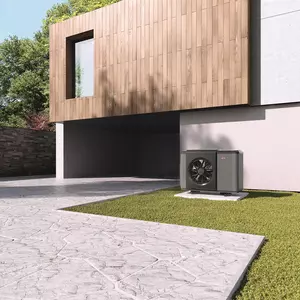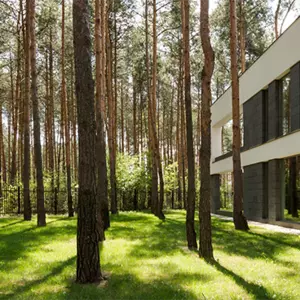
Retrofitting a heat pump
Also suitable for use in old buildings
While heat pumps are the most popular heating system for new buildings, many homeowners miss out on their benefits because they mistakenly think that they are not suitable for existing buildings. In actual fact, adding a heat pump is a good choice in most cases. We will show you how to make the switch in the best possible way.
The heat pump is already a high-flyer in new buildings
Heat pumps account for over 60% of heating systems in new buildings. Their high level of efficiency and sustainability makes them the standard choice. All a heat pump needs to generate heat is a little electricity. Retrofitting a heat pump heating system in an old building is possible in most cases. Whether it makes economic sense and can be implemented in an energy-efficient manner will depend on a number of factors.
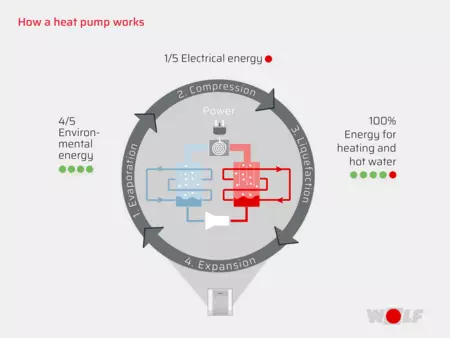
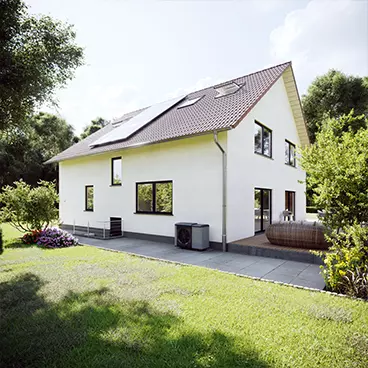
What are the advantages of retrofitting a heat pump?
There are a number of advantages to retrofitting a heat pump: by investing in a future-proof system, you can reduce your CO2 emissions and even cut your heating costs in the long run. If you decide to install a photovoltaic system as well, you can even generate the electricity you need to run the heat pump yourself. Adding a solar thermal system can be a useful way to boost DHW heating in the heating system. Subsidies are usually available for heating systems, allowing you to significantly reduce the relatively high purchase costs. These subsidies are available for both new builds and modernisation projects in existing buildings.
The most important advantages of retrofitting a heat pump at a glance:
No dependence on fossil fuels and reduced exposure to price hikes
Reduced consumption of fossil fuels
Reduced greenhouse gases and other emissions
Less space required (no fuel storage, etc.)
Requirements for efficient retrofitting of a heat pump
Heat pumps requires electricity to operate the control unit and pumps and generate energy. This is done by using a compressor to increase the temperature of the ambient energy. The system works similarly to a refrigerator in reverse, where the interior is heated and not cooled. Raising the temperature level is essential in order to achieve the required flow temperatures of the heating and hot water supply.
Heat pumps can be retrofit with a flow temperature of up to 55°C
Contrary to popular opinion, heat pumps work very efficiently with flow temperatures of up to 55°C. This is precisely why they are a perfect match for existing buildings with traditional radiators. It is important to remember that this maximum flow temperature will rarely be needed. Unless the temperature outside is well below freezing, the required flow temperature will be much lower. The worry that you will have to renovate your house before using a heat pump is therefore unfounded.
How to lower the system temperature of your heating system
Nevertheless, lowering the system temperature of the heating system still makes sense as it will reduce the amount of energy used by the system. The system temperature includes both the flow and the return temperature of your heating system.
Traditional radiators usually require higher flow temperatures to heat living spaces than a radiant heating system (e.g. underfloor heating). Converting to underfloor heating can reduce the energy requirements of your home in a sustainable way and save you money over the long term. In most cases, however, replacing individual, smaller radiators with more modern ones will usually be enough in order for the heat pump to run efficiently.
Another important factor is the condition of the building’s insulation. The less heat the house loses through poorly insulated roofs, façades, windows and doors, the less heat the heating system will need to compensate. Even small steps like insulating the ceiling on upper floors can provide significant improvements.
In existing buildings, performing a heating load calculation is often worthwhile. Experts use these calculations to determine how much energy is lost through a building’s out shell and through ventilation. This makes it possible to determine how powerful the heating system needs to be to suit your needs.
Any radiator that requires a flow temperature higher than 55°C can be replaced with a larger one. Given the right conditions, air source heat pumps are easy to integrate without much additional effort. In contrast to ground source and water source heat pumps, they do not require any excavation work.
Air-to-water heat pumps
CHA-MONOBLOCK
The CHA Monoblock air source heat pump from WOLF is one of the most efficient air source heat pumps on the market. It is low-maintenance, made in Germany and comes with a five-year warranty. It also has a stylish design.
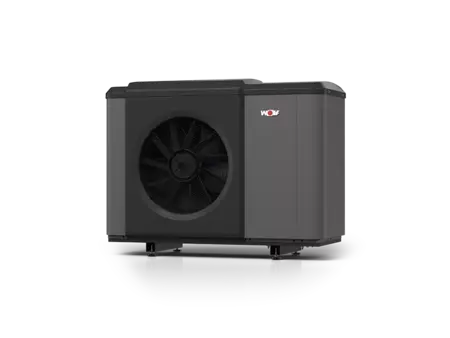
Retrofitting heat pump heating: how much effort is required to retrofit a heat pump in an old building?
The time and expense involved in retrofitting a heat pump heating system depends largely on the type of heat pump. Whereas water-to-water heat pumps and brine-to-water heat pumps sometimes require development work that requires a permit, air-to-water heat pumps can be integrated flexibly and easily.
A heat pump can serve as the main heat source
You may well be considering combining a wood, oil or gas condensing boiler in your existing building with a heat pump. Hybrid heating systems are possible, but only really make sense in certain situations, such as when flow temperatures below 55°C are not available. Since the heat pump heats the house reliably all year round, there is no need for another heating system. Sole advantage: In an extreme emergency (for example if the heating pump fails), the conventional heating system can step in.
The “Agora Energiewende” publication by the Öko-Institut e.V. and the Fraunhofer Institute for Solar Energy Systems ISE also confirms that heat pumps should be used as the main heat generator in unrefurbished buildings. According to this report, heat pumps always work more efficiently than gas heating systems down to a temperature of -12°C, even in existing buildings. This means that there is no need to switch on the gas heating.
The report also found that heat pumps outperform gas heating systems in terms of operating costs for 96% of the total annual heat supply. This small percentage hardly offsets any of the purchase costs of the gas heating system.
When is replacing your old heating system the better choice?
If your conventional heating system is already very old, it will no longer be working efficiently and will produce more environmental pollution than necessary. The wear and tear on old heating systems makes them more susceptible to repair. In such cases, you should definitely check whether it is worth upgrading your current heating system to a heat pump. In the long run, this will save you a lot of money.
However, switching to a heat pump might also be of interest for anyone still using conventional fuels to generate heat. Even fairly new fossil fuel-based systems involve significantly higher utility bills than an environment friendly heat pump. By switching, you can make yourself less dependent on market trends, secure your energy supply over the long term and do something for the environment.

Top advice from WOLF
If you are looking for an efficient heat pump for your existing building or a new build, you should seek in-depth advice. Correct dimensioning and careful planning are crucial for efficient heating. The experts at WOLF will be happy to help you.
Conclusion: It has never been a better time retrofit a heat pump
If you are looking to retrofit a heat pump heating system, you have a number of options available to you. Depending on your requirements, air-to-water, geothermal or water source heat pumps are the best choice in almost every case. It is always important to have a plan that takes into account the overall condition of the building. The costs involved depend on many different factors, so you should contact a heating engineer for a consultation. Our experts would be happy to help you with this. We can also provide some information about the subsidies that are currently available for your heating system.
